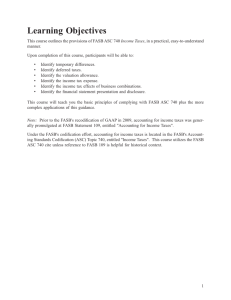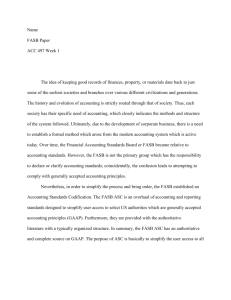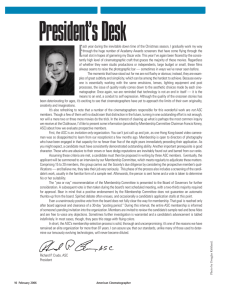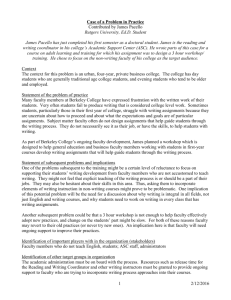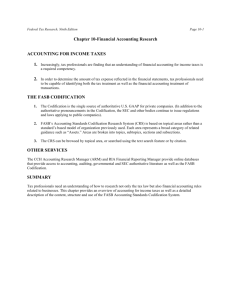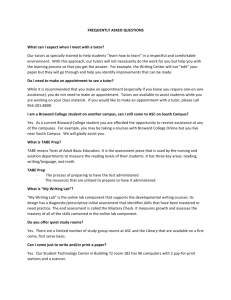Demystifying the Accounting Standards Codification
advertisement
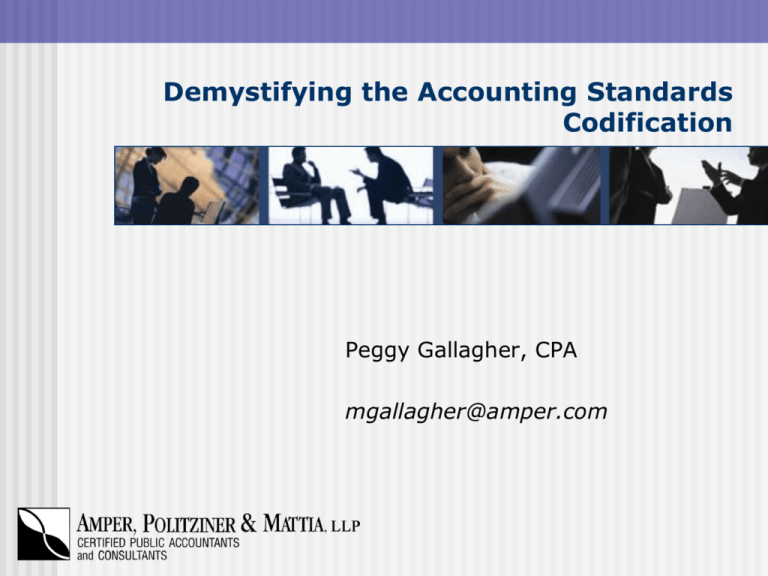
Demystifying the Accounting Standards Codification Peggy Gallagher, CPA mgallagher@amper.com Demystifying the Accounting Standards Codification What is it? When is it effective? How will it affect me? Resources Overview of the Codification FASB’s Accounting Standards Codification (“ASC”) Does not change US GAAP Integration and categorization Includes most SEC content Why was the ASC needed? Simplifies access Improves accuracy of research Mitigates risk of non-compliance Streamlines research process Provides real-time updates Assists with IFRS convergence Before the ASC FASB statements ~ FASB Staff Positions ~ FASB Interpretations ~ Accounting Principles Board Opinions ~ EITF Abstracts ~ AICPA Audit & Accounting Guides ~ FASB Technical Bulletins ~ SEC S-X Rules ~ SEC Staff Accounting Bulletins ~ AICPA Statements of Position ~ SEC S-K Items ~ SEC Speeches ~ AICPA Practice Bulletins ETCETERA What’s Not in the ASC Governmental standards Non-GAAP standards (modified cash basis, income tax basis or regulatory basis) “Non-essential” content of previous standards Basis for Conclusions Document summary Constituent feedback What’s Not in the ASC (cont.) FASB used 12-31-08 as a target date for authoring Content amended or superseded by FIN 48, SFAS 141(R) Pre-SFAS 158 literature (employers’ accounting for DB plans) Generally, most other grandfathered material SEC Standards “SEC content is the domain of the SEC” “Relevant” SEC materials included to “increase the utility” of the ASC, in separate sections Regulation S-X, Financial Reporting Releases, Accounting Series Releases, SABs, SEC Staff Observer comments are in Content related to the following is EXCLUDED: MD & A Auditing matters Independence matters How the ASC is Structured New citations: “ASC 210-20-60-5” or ASC XXX-YY-ZZ-PP New classification system Areas – 5 groupings of topics Topics = XXX = 210 Subtopics = YY = 20 Sections = ZZ = 60 Paragraph or subsections = P or PP = 5 ASC Areas and Topics (“XXX”) Approximately 90 topics, in 5 main areas General Principles (105 – 199) • Example: 105, GAAP Presentation (205 – 299) • Balance sheet, Statement of Cash Flows, EPS Financial Statement Accounts (305 – 700) • Receivables, Equity, Revenue Recognition Broad Transactions (805 – 899) • Leases, Business Combinations, Consolidation Industry ( 905 – 999) Topic – “Broad Transactions” 805 808 810 815 820 825 830 835 840 845 850 852 855 860 – – – – – – – – – – – – – – Business Combinations Collaborative Arrangements Consolidation Derivatives and Hedging Fair Value Measurements and Disclosures Financial Instruments Foreign Currency Matters Interest Leases Nonmonetary Transactions Related Party Disclosures Reorganizations Subsequent Events Transfers and Servicing Topic – “Presentation” 205 210 215 220 225 230 235 250 255 260 270 272 275 280 – – – – – – – – – – – – – – Presentation of Financial Statements Balance Sheet Statement of Shareholder Equity Comprehensive Income Income Statement Statement of Cash Flows Notes to Financial Statements Accounting Changes and Error Corrections Changing Prices Earnings per Share Interim Reporting Limited Liability Entities Risks and Uncertainties Segment Reporting ASC Subtopics (“YY”) Distinguished by type or scope All will contain “Overall” – pervasive guidance for topic Remainder will vary by topic Example Topic: Leases Subtopics: Overall, Operating, Capital ASC Sections (“ZZ”) Standardized across all Subtopics 16 categories, examples: 00, Status 05, Overview and Background 15, Scope and Scope Exceptions 25, Recognition 50, Disclosure SEC: “S” before Section number, i.e., S USER TIP Select the feature “Join all Sections” in order to combine each element of this backbone into one, seamless discussion Example: Join the Disclosure section for all subtopics within the Revenue Recognition Topic USER TIP Q: How will I be able to find the original source (old standards) of the ASC material? A: The Codification includes a cross-reference report that allows users to identify where current standards reside in the Codification, or the source of material included in the Codification. (see example) Future Codification Updates Accounting Standard Updates or “ASUs” Numbered by year of issuance, ASU 2009-01 or ASU 0901 15 issued since July 1, 2009 Several “Proposed ASUs” Same look and feel as pre-ASC standards Codification Updates Current and transitional text presented together in ASC Transitional text = not yet effective Transitional text will be distinguished from current (authoritative) text FASB does not consider them authoritative as an ASU (no references to ASU 2009-10) FASB Exposure Draft Information FASB.org Similar format to ASUs Click on “Projects” tab, then “Exposure Drafts” Sign up for “Action Alerts” : Send an email to joinactionalert@listserv.lists.fasb.org confirmation email will be sent back to you all newly issued ASUs, Exposure Drafts and FASB Activity will be emailed to you Before and After “Old” citation SFAS 5 SFAS 109/FIN 48 SFAS 142 SFAS 157 “New” ASC Citation ASC 450, Contingencies ASC 740, Income Taxes ASC 350 Intangibles – Goodwill and Other ASC 820 Fair Value Measurements and Disclosures Before and After OLD SOP 94-6, Significant Risks & Uncertainties FAS 141(R), Business Combinations SFAS 123(R) NEW ASC 275, Risks & Uncertainties ASC 805 Business Combinations ASC 718 , Compensation – Stock Compensation Afraid to Change? Two ways of linking ASC materials to old standards: Cross reference tool Select “Printer friendly with Sources” view Effective Date Became authoritative on July 1, 2009 Mandatory for interim and annual periods ending AFTER September 15, 2009 For public companies: Q3 Accounting Citations – Going Forward Periods ending before September 15, 2009: Do NOT refer to ASC only May use “old” references only, or both Periods ending after September 15, 2009: Refer to ASC only, may NOT use “old” references Comparative statements: may use both USER TIP Streamline: remove unnecessary, outdated technical references in footnotes Consider: deleting all technical citations in favor of a “Plain English” approach (recommended) Example: “….as required by the Derivatives and Hedging Topic of the FASB ASC…” Not Just for Financial Reports Other documents impacted by ASC: Internal policy manuals, memos, etc Management’s Discussion and Analysis (MD&A) (public companies only) Transition Planning ASC structure requires practice and training Old standards may be split across several topics Review financial statements and identify where changes are needed Update all internal policies, memos, etc. Determine how you will access the Codification Resources FASB website (www.fasb.org) FASB on-line tutorials (free) FASB “Notice to Constituents” for ASC (free) FASB online ASC annual subscription, $850; print (4 volumes), $195 AP & M website QUESTIONS ????????? “The material contained in this presentation is for general information and should not be acted upon without prior professional consultation.”

